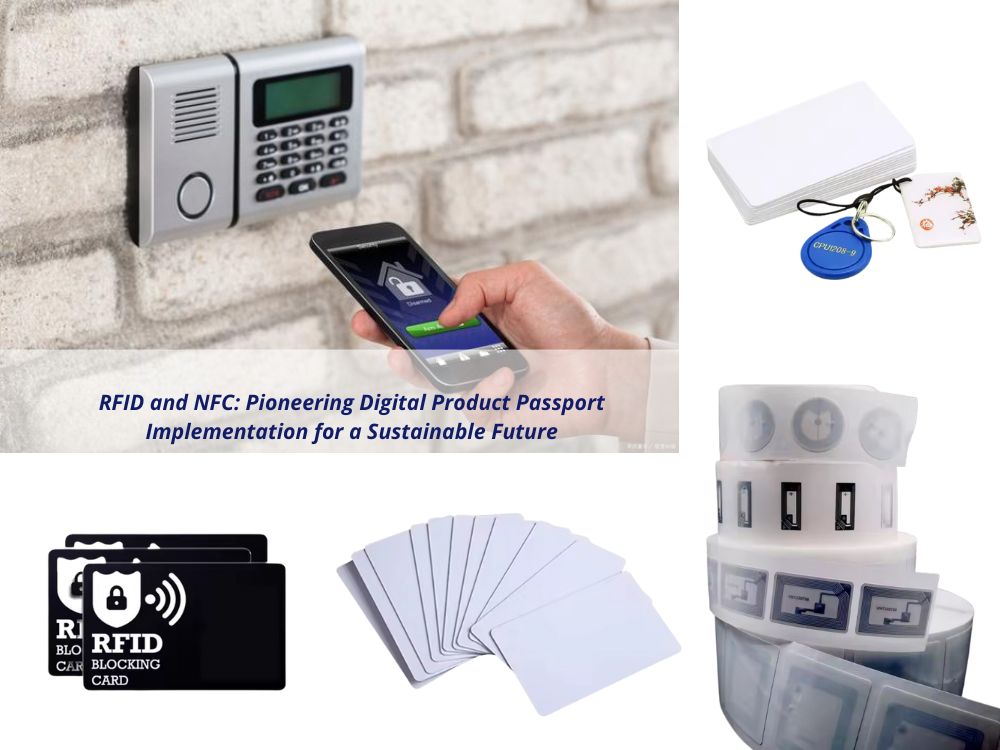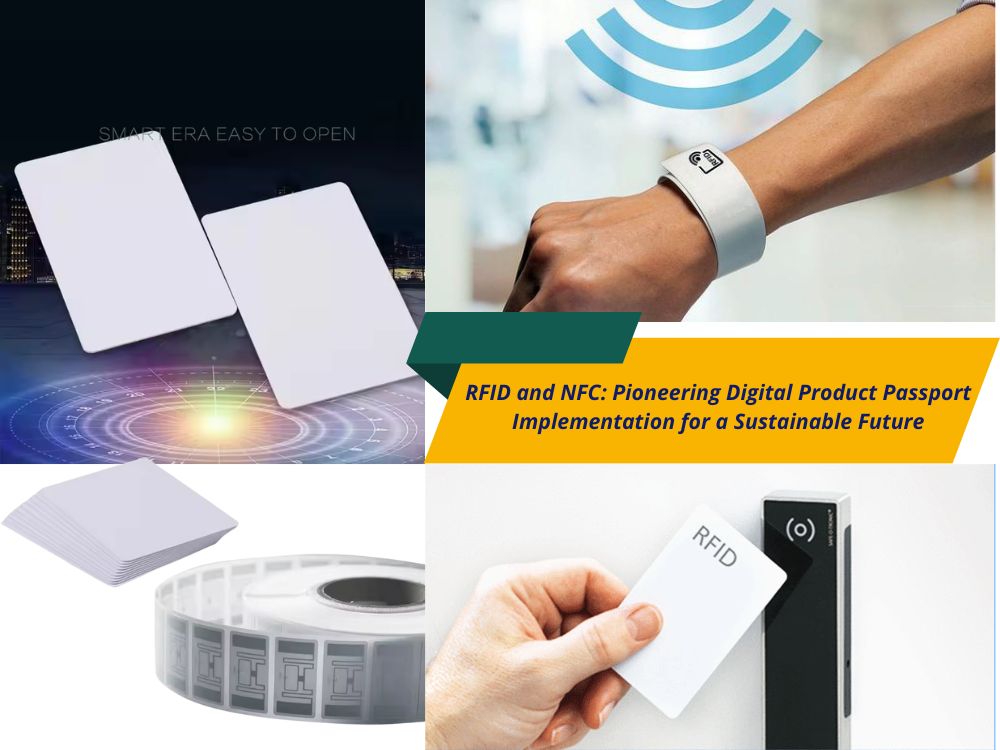
RFID and NFC: Pioneering Digital Product Passport Implementation for a Sustainable Future
Table of Contents
Summary
Utilizing unique identifiers to collect and share data, DPPs offer a structured way to monitor a product’s lifecycle, from raw material extraction to its end-of-life stage. The implementation of RAIN RFID and NFC technologies as data carriers within DPPs is critical, as these technologies offer significant advantages in terms of scalability, compatibility, and security. The European Union’s Ecodesign for Sustainable Products Regulation (ESPR), set to begin in 2027, will mandate the use of DPPs, making early adoption crucial for companies aiming to stay competitive in the global market.

The Role of the Digital Product Passport (DPP) in Circular Economy
The Digital Product Passport (DPP) is designed to enhance product lifecycle transparency, providing a digital twin for every product and promoting sustainability by tracking key data across various stages of production and use. Governed by the ESPR, the DPP will be mandatory for products sold within the European Union starting in 2027. The data carrier plays a critical role in connecting physical products with their digital records, ensuring that essential information is accessible at every point in the value chain.
Key Challenges and Industries Impacted by the DPP
The introduction of the DPP will significantly impact several key industries, including:
- Electronics and ICT
- Batteries and Vehicles
- Textiles
- Steel
- Plastics
- Furniture
- Construction and Buildings
- Chemicals
Each industry will face unique challenges in implementing the DPP, with the initial focus on enhancing circularity and reducing environmental impact. For instance, the textile industry, known for its significant waste generation, will be one of the first sectors required to adopt DPPs, starting in July 2027.
Advantages of RFID and NFC as Data Carriers for DPP
Selecting the right data carrier technology is essential for the successful implementation of the DPP. While various options, such as barcodes, QR codes, and Bluetooth tags, are available, RFID and NFC technologies stand out due to their superior capabilities. Below, we explore the key advantages these technologies offer as data carriers for the DPP.
Unique Identifier and Authenticity
RFID and NFC tags provide a Unique Identification Number (UID) for each product, ensuring that every item can be distinctly identified. This feature is particularly valuable for preventing counterfeiting and ensuring product authenticity—a critical consideration in industries like luxury goods and electronics.
Superior Compatibility Across Platforms
RFID and NFC technologies are highly compatible across various platforms, adhering to ISO/IEC standards, including ISO/IEC 15459:2015. This ensures that the data stored on these tags is open, structured, and easily accessible, making these technologies versatile and widely applicable for DPP implementation.
Scalability and Interoperability for Mass Data Collection
The scalability and interoperability of RFID and NFC are vital for managing the vast amounts of data required by the DPP. RAIN RFID enables rapid, automatic data collection without the need for direct line-of-sight, making it ideal for large-scale manufacturing environments. Meanwhile, NFC technology facilitates consumer engagement and digital authentication, especially in industries like luxury branding.
Strong Data Security and Digital Storage
RFID and NFC technologies offer robust data security features, including encryption, making them more secure than traditional data carriers. These technologies also provide varying storage capacities, with RFID tags capable of storing up to 128 KB of data and NFC tags ranging from 48 bytes to 1 MB. This flexibility ensures that essential product data can be securely stored and accessed throughout the product’s lifecycle.
Easy Access and Long Durability
The ease of access provided by RFID and NFC technologies is another key advantage. RAIN RFID tags can be read from long distances and by machines, facilitating efficient supply chain operations. NFC tags, on the other hand, can be easily read by most smartphones, enhancing consumer engagement. Additionally, these technologies are designed for long-term durability, lasting at least 20 years under typical conditions, making them reliable for storing information throughout the entire product lifecycle.

Application of RFID and NFC Technologies in DPP Across Industries
Industry | Challenges Addressed by DPP | RFID/NFC Benefits |
Electronics and ICT | Tracking lifecycle data, ensuring authenticity | Unique ID, data security, scalability |
Batteries and Vehicles | Monitoring raw material usage, emissions, and end-of-life disposal | Secure data storage, long durability |
Textiles | Reducing waste, tracking recycled vs. virgin materials | Compatibility, easy access, consumer engagement |
Steel and Plastics | Reducing carbon footprint, ensuring circularity | Scalability, interoperability |
Construction and Buildings | Monitoring materials and emissions throughout the project lifecycle | Data security, long-term durability |
Furniture and Chemicals | Managing environmental impact and compliance | Superior compatibility, easy access for stakeholders |
Conclusion: Embracing RFID and NFC for Future-Ready DPP Implementation
The implementation of the DPP represents a significant shift toward sustainability and circularity across industries, with RFID and NFC technologies playing a pivotal role as data carriers. By offering unique identifiers, superior compatibility, scalability, and strong data security, these technologies enable efficient and reliable data management throughout a product’s lifecycle. As the ESPR regulations take effect, companies that adopt RFID and NFC for DPP implementation will be well-positioned to lead in the global shift toward sustainability. With the first phase of DPP implementation set for 2027, now is the time for companies to invest in the necessary technologies and infrastructure to stay ahead in this rapidly evolving market.
Comments
Hot Products

What Is RFID Waste Management
Imagine a city where every trash bin speaks — not literally — but through a tiny chip that tells the system when it’s full, when it’s emptied, and where it went. That’s what RFID waste management is doing today.

What are Bolt Seals and their Applications? | Complete Guide
In global trade and logistics, bolt seals play a crucial role in ensuring cargo security and compliance. These small but powerful devices are designed to lock shipping containers, trailers, and cargo doors with a tamper-evident mechanism.

What is an RFID Card Protector? Benefits, Use Cases, and Buying Guide
RFID technology (Radio Frequency Identification) is everywhere: in your credit cards, ID badges, transit passes, hotel room keys, and more. It offers speed and convenience, but it also opens the door to a new kind of digital theft called “skimming.” That’s where an RFID card protector comes in.

RFID Wristbands for Events: Bulk Buying Guide for Organizers
RFID wristbands for events are becoming the go-to solution for organizers who need faster entry, fraud prevention, and cashless payments at concerts, festivals, and sports venues. Unlike paper tickets or QR codes, these smart wristbands use embedded chips to streamline access, secure transactions, and improve the guest experience.

How RFID Tag on Windscreen Improves Vehicle Access Control and Toll Systems
In today’s fast-paced world, vehicle identification needs to be quick, secure, and contactless. An RFID Tag on the Windscreen provides exactly that — a reliable way to manage toll collection, parking, and gated access without stopping vehicles.

The Benefits of RFID Linen Tags in Commercial Laundry
Managing laundry in hospitals, hotels, or large laundry services is a big job. Each day, thousands of sheets, towels, and uniforms are washed, sorted, and sent back out. But problems like lost linens, sorting mistakes, and manual counting can cost companies a lot of money. For example, mid-sized hotels can lose over $200,000 each year from missing linens.
That’s where RFID Linen Tags come in.
Tags
RELATED BLOGS

What Is RFID Waste Management
Imagine a city where every trash bin speaks — not literally — but through a tiny chip that tells the system when it’s full, when it’s emptied, and where it went. That’s what RFID waste management is doing today.

What are Bolt Seals and their Applications? | Complete Guide
In global trade and logistics, bolt seals play a crucial role in ensuring cargo security and compliance. These small but powerful devices are designed to lock shipping containers, trailers, and cargo doors with a tamper-evident mechanism.

What is an RFID Card Protector? Benefits, Use Cases, and Buying Guide
RFID technology (Radio Frequency Identification) is everywhere: in your credit cards, ID badges, transit passes, hotel room keys, and more. It offers speed and convenience, but it also opens the door to a new kind of digital theft called “skimming.” That’s where an RFID card protector comes in.




